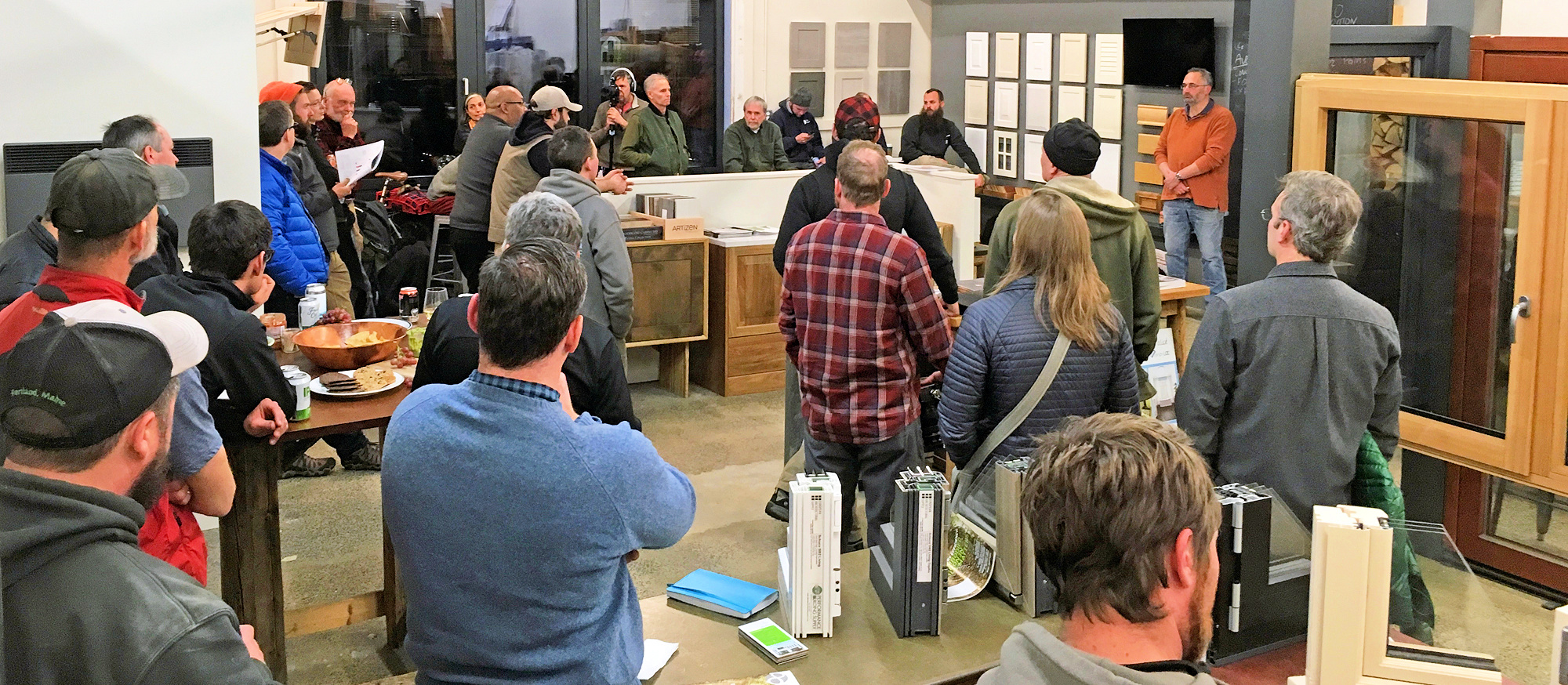
Pictured above: Pretty Good House 2.0 discussion at Performance Building Supply
You may already know about the Pretty Good House concept, the result of a question that moderator Dan Kolbert asked back in 2011, partly as a joke, at the long-running building science discussion group at Performance Building Supply in Portland, Maine. Fed up with other building standards, from the wimpy and under-enforced building code to the nit-picky Passivhaus, Dan asked, essentially, what should you include in a house that does right for its inhabitants and the planet, but that does not go beyond reasonable environmental or financial payback.
 We developed a list, which I shared in a blog post on greenbuildingadvisor.com, and since then the idea has taken on a life of its own. A lot has changed since 2011, and—unfortunately, perhaps—the time has come to revisit the Pretty Good House, also known as PGH.
We developed a list, which I shared in a blog post on greenbuildingadvisor.com, and since then the idea has taken on a life of its own. A lot has changed since 2011, and—unfortunately, perhaps—the time has come to revisit the Pretty Good House, also known as PGH.
Reducing embodied carbon in buildings—especially in Pretty Good Houses—was the topic at the last two building science discussion groups in Portland, then at one of the BS + Beer events I moderate in Liberty, Maine. (“BS” for Building Science, of course.) Right now is the worst time in the history of our species to dump a lot of carbon into the atmosphere, but that’s exactly the result of many construction practices. Even builders concerned with energy efficiency often front-load enormous amounts of carbon-intensive materials with the expectation of saving over the life of the building. But if we only have one or two decades to mitigate the worst impacts of climate change, what should we do instead? The following ideas are a summary of our discussions.
Like everything PGH, the 2.0/Low Carbon Edition is meant for thought, discussion and action, not for check boxes, awards or membership dues. As always, however, if you feel that you deserve a plaque, feel free to buy yourself one.
In no particular order, a PGH 2.0/Low Carbon Home should:
- Be as small as possible. Ideally with multi-family or multi-generational occupants.
- Be PV-ready or include photovoltaic panels. PV-ready means designed, built and sited in such a way that a reasonably-sized photovoltaic array can handle all of the home’s energy needs on an annual basis. (PV panels pay their carbon debt in 2-4 years.)
- Be simple and durable. Simple shapes are easier to air-seal and insulate, perform better in harsh weather, and require fewer materials and less maintenance than more complicated buildings. If you need to bring in a structural engineer, your design might be too complicated. Invest in the parts that are hard to change later.
- Use wood and wood-derived products as construction materials. Just make sure the wood is sustainably harvested, locally if possible. Otherwise the trees are better left to remove CO2 through photosynthesis. The more materials are processed, in general, the higher their carbon footprint.
- Use air-source heat pumps. Mini-splits can be efficient to -15°F or below, affordable (especially for the sizes needed in a PGH) and relatively simple to install. For those who can’t stand the look of an appliance on the wall, there are slim-duct, ceiling cassette, and floor-mounted versions. But the wall-mounted units are the most efficient, so learn to love them. Heat-pump water heaters are a no-brainer for most homes.
- Invest in the envelope. Insulation and air-sealing should be good enough that heating and cooling systems can be minimal, with indoor air quality and comfort levels that are very high.
- Be affordable, healthy, responsible and resilient.
- KISS: Keep It Simple + Safe, easy to operate and understand. Use owner-proof systems to get around operator influence.
- Consider traditional, non-flashy approaches: deciduous trees shading south and west walls; cooling via fans and natural convection instead of air conditioners; use biomass secondary water heating (i.e., let your wood stove heat your water); air-dry your clothes.
- Be part of a sustainable community: have access to community solar, jobs and services nearby that minimize driving, and shared infrastructure costs, to name a few advantages. A one-hit wonder in the middle of the woods often comes with a bigger carbon footprint than a community-based home.
A PGH 2.0/Low Carbon Home should minimize or avoid:
- Concrete, which contributes 10% of man-made global warming emissions, partly through fuel to heat and move minerals, but 60% from release of carbon dioxide (CO2) from limestone (CaCO3) to get calcium oxide (CaO) for Portland cement. One concrete-reducing technology that is gaining ground is helical metal piers, which are screwed into the soil to support decks, houses and more. Some engineers and builders have doubts, but with many thousands of installations, they have a proven track record.
- Foam, especially HFC (hydrofluorocarbon)-blown closed cell spray foam and XPS (extruded polystyrene) rigid insulation. When building a new house there should be no need to use foam above grade.
- Combustion appliances, especially those that burn fossil fuels. You can have a wood stove in a PGH but make sure it’s EPA-certified and include dedicated makeup air.
- Unhealthy materials.
Some bigger ideas to consider:
- Straw bale construction. Dismissed by many as low-tech, low-R and prone to moisture damage, experienced straw bale builders have developed effective ways to use this carbon-sequestering approach to building.
- Phenolic rigid foam. Zero greenhouse-gas emissions, extremely high R-value—what’s not to love? The fact that it’s impossible to get.
- Mycelium insulation. (Cue “fungus among us” jokes.) But seriously—it sequesters carbon and traps air, so why not use it to insulate homes?
- “Smart” materials. Variable-permeance membranes have made many of us more confident about simple but theoretically-risky assemblies like double stud walls and building without foam. Glazing has come a long way in the last 10-20 years, but we could benefit from more glazing and other materials that respond passively to changes in conditions.
- Offsite fabrication. There is a lot of carbon burned getting workers and materials to job sites, and a lot of efficiency and quality control possible in a factory setting.
Prescriptive Guidelines
The original PGH had simple rules for insulation and airtightness, borrowed from Dr. Joe Lstiburek of Building Science Corp. as his recommendations for efficient homes in a cold climate. For PGH 2.0, we need to update it a bit to account for easy access to better windows and a better understanding of embodied carbon.
In a cold climate, DOE climate zone 5 or 6, use:
- R-5 to R-8 windows (U-0.20 to U-0.13); the higher the glazing-to-wall-area ratio, the more important the windows’ U-value. Even the best windows make lousy walls, so don’t over-glaze.
- R-10 sub-slab insulation (EPS/Expanded polystyrene, mineral wool or recycled XPS).
- R-20 foundation wall, frost wall or slab perimeter insulation (or build on piers).
- R-40 walls.
- R-60 roof.
- The wall and roof values should be lower if you’re using foam, due to its long carbon payback, but in a PGH 2.0 there is no reason to use foam above grade.
- Airtightness: 1.0 ACH50 (air changes per hour at ±50 Pascals pressure) is the maximum air leakage target many of us are using, but others say 1.5 or 2.0 ACH50 is tight enough. Definitely stay well below code-minimum 3.0 ACH50. Going tighter than 1.0 ACH50 gets you cool-kid points but may not add significantly to your home’s performance.
Performance-Based Approach (Optional)
- Use energy modeling to optimize designs, especially for fine-tuning window performance values. (BeOpt is a good, simple, free program for this.)
- Should there be a standard PGH energy-use target, such as xx% better than code-minimum, xx% of Passive House levels, xx Btu/ft² or xx Btu/occupant?
Additional thoughts:
- Our generation is the only one who can fix the climate change problem. We can’t opt out; this is our only chance.
- Aim for the biggest targets, don’t get lost in the weeds.
- If you’re a designer or builder, sell the comfort aspect of a PGH; many clients do not understand or want to hear about technical details or climate change.
- We need a carrot and stick approach: improve building codes and enforce them.
- We need affordable and effective PGH 2.0 retrofits.
- Read the Project Drawdown website or book for 100 more ways to reach carbon-neutral emissions.
- Read Bruce King’s The New Carbon Architecture to learn more about reducing embodied carbon in buildings.
What would you include (or avoid) in a Pretty Good House 2.0/Low Carbon Home?
Our Mission
NESEA advances sustainability practices in the built environment by cultivating a cross-disciplinary community where practitioners are encouraged to share, collaborate and learn.





One aspect of this discussion worth thinking about is that most of us have no experience/intuition about what a good kg CO2e/sf metric would be for our projects. To compare with energy usage - many of us have a target called zero annual net energy usage that we've been able to accomplish. Previous to proliferation of onsite renewable generation (due to vastly increased affordability) many of us had energy use targets for our buildings (even before Passivehouse, believe it or not :-) that guided our design efforts - we knew what "good" was (or "pretty good"). Now transfer this to low embodied carbon buildings. Should our goal be net zero carbon? What does that mean? If it's possible, is it within our grasp now, or do we need different products/manufacturing methods/feedstocks to even begin to contemplate that goal? On the way to that goal, what's a good metric?
For me, the most useful way to learn this is to look at case studies of embodied carbon in buildings. I'm a noobie in this arena, there are NESEA members who are deep into it - one resource is this link http://carbonleadershipforum.org/data-visualization/. Check it out and begin to get some feel for the units of measurement, and the ranges of values tabulated.
Marc, I see your point, and thank you for the link. Having a good understanding of what a kg of CO2 emissions "looks like" would definitely be helpful; as they say, what gets measured gets improved. But measuring CO2e (for the few who may not know the acronymn, that's carbon dioxide equivalent, a more precise term for talking about carbon emissions) does not seem simple, and that may be a problem for a simple (or simple-minded?) approach like the PGH.
I'm not sure what the answer is. Net zero carbon seems like it could be a stretch, if mass adoption (and climate-saving) is the goal. Or perhaps that's exactly what the metric should be.
Great blog post, thank you. Following up on Mark's response, when I first began looking at energy efficient construction and energy efficiency in general to combat the 'energy crisis' in the late 70' and 1980's, climate change, and hence 'low carbon', where not even in the discussion. Fast forward, and we are in a new paradigm. Building low carbon on top of net zero or passive house or PGH requires an new set of rules. What you listed above is a great start. It has been difficult enough, and taken many years (decades) to change the code to address energy let alone carbon. We will probably need several more decades to get this right as well. This is a good starting point. While it would be ideal for market forces to instigate this change, it seems like that will not be the case (usually isn't) and it will require legistative action. Maybe a carbon tax will help or better, a low carbon construction tax deduction/credit.
On a seperate but related note, from the Boston Globe Today: Vermont Carbon Culprit Exemplifies the difficult road ahead.
Keep up the good work!!
I wanted to add that inspiration for PGH 2.0 largely came from the BE18 session last spring by Ace McCarleton, Jacob Racusin and Chris Magwood about embodied carbon vs. operating carbon in our buildings. I think it's safe to say that most of the standing-room-only crowd was surprised, to say the least, at their graphic representation of just how much embodied carbon matters in relation to the climate change crisis.
Hi Mike
I am trying to find out where the discussion of retrofitting existing buildings is? Your post seems to be on the topic in regards to new construction. I agree with your excellent recommendations. I think the problem with new construction is planned obselscense and all things that cannot be repaired. The efficiency and carbon savings of materials and appliances is not valid if it has to be replaced on a regular basis. I specialize in weatherizing old repairable windows and tell people that new windows cannot be repaired and will break down in the next 10-30 years. The same can be said for energy saving appliances. I would love to have more talks about this problem in new high performance buildings. Thanks Chris Pratt